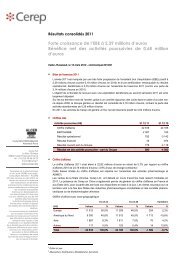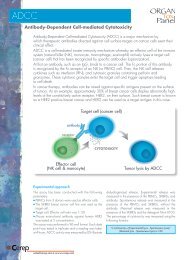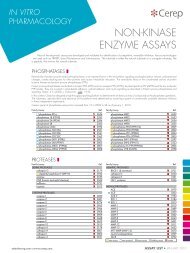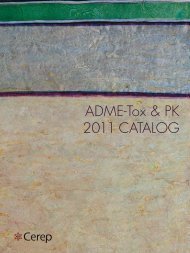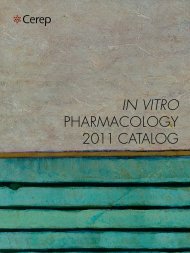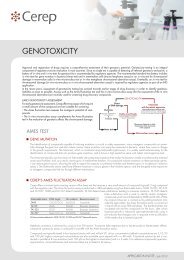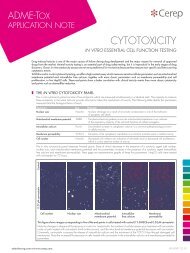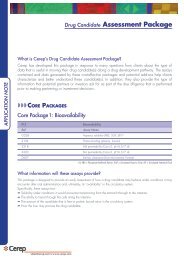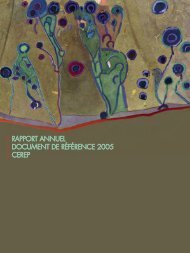Z-338 - Cerep
Z-338 - Cerep
Z-338 - Cerep
You also want an ePaper? Increase the reach of your titles
YUMPU automatically turns print PDFs into web optimized ePapers that Google loves.
Involvement of CYP2C8 and UGT1A9 in the<br />
metabolism of a novel gastroprokinetic agent, Z-<strong>338</strong><br />
S. Furuta 1 , E. Kamada 1 , T. Sugimoto 1 , Y. Kawabata 1 ,<br />
X. C. Wu 2 , J. Skibbe 3 , E. Usuki 3 , A. Parkinson 3<br />
and T. Kurimoto 1<br />
1<br />
Central Research Laboratories, ZERIA Pharmaceutical<br />
Co., Ltd., Saitama, Japan<br />
2<br />
<strong>Cerep</strong> Inc., WA, USA<br />
3<br />
XENOTECH, L.L.C., KS, USA
Introduction<br />
Z-<strong>338</strong> is a novel gastroprokinetic agent, which is<br />
synthesized by Zeria Pharmaceutical Co., Ltd (Fig. 1).<br />
Z-<strong>338</strong> is under development for the treatment of<br />
functional dyspepsia, and is now in clinical trials.<br />
The purpose of the study was to evaluate possible<br />
involvement of cytochrome P450 (CYP) enzyme(s) and<br />
UDP-glucuronosyltransferase (UGT) enzyme(s)<br />
responsible for metabolizing Z-<strong>338</strong>.<br />
Potential interactions of Z-<strong>338</strong> with CYP enzymes were<br />
also investigated, and we compared its inhibitory<br />
potentials with cisapride and Z-<strong>338</strong> analog, ID951551.
CYP2C8<br />
(>>CYP3A4 or 1A1)<br />
MeO<br />
O<br />
N<br />
H<br />
S<br />
N<br />
O<br />
N<br />
H<br />
N<br />
H<br />
MeO<br />
O<br />
N<br />
H<br />
S<br />
N<br />
O<br />
N<br />
H<br />
N<br />
MeO<br />
OH<br />
Z-<strong>338</strong> deisopropyl metabolite<br />
MeO<br />
MeO<br />
MeO<br />
O<br />
OMe<br />
OH<br />
N<br />
H<br />
Z-<strong>338</strong><br />
S<br />
N<br />
N<br />
H<br />
ID951551<br />
O<br />
N<br />
UGT1A9<br />
(>>UGT1A8)<br />
MeO<br />
MeO<br />
CYP2C8<br />
(>CYP3A4 or 1A1)<br />
MeO<br />
MeO<br />
O<br />
OGlu<br />
N<br />
H<br />
O<br />
OMe<br />
S<br />
N<br />
H<br />
N<br />
S<br />
N<br />
O<br />
O<br />
N<br />
H<br />
Z-<strong>338</strong> glucuronide<br />
ID951551 deisopropyl metabolite<br />
N<br />
H<br />
N<br />
N<br />
H<br />
OCH 3<br />
H 3 CO<br />
CYP3A4<br />
OCH 3<br />
H 3 CO<br />
F O(CH 2 ) 3 N NHCO<br />
NH 2<br />
HN<br />
NHCO<br />
NH 2<br />
Cisapride<br />
Cl<br />
N-dealkylcisapride<br />
Cl<br />
Fig.1 Metabolic Scheme of Z-<strong>338</strong>, ID951551 and Cisapride
Method: In vitro metabolism study<br />
HPLC methods that were validated for the quantification of Z-<strong>338</strong>,<br />
Z-<strong>338</strong> deisopropyl metabolite and ID951551 were employed.<br />
Z-<strong>338</strong> and ID951551 were incubated with a panel of recombinant<br />
human enzymes to investigate possible involvement of CYP and<br />
UGT enzymes responsible for the metabolism of Z-<strong>338</strong> and<br />
ID951551. rCYP and rUGT enzymes were obtained from Gentest<br />
Corporation (Woburn, MA) or Cypex Ltd, (Scotland, UK) . Once<br />
initial rate conditions were established, Km and Vmax were<br />
determined for the dealkylation of Z-<strong>338</strong> by human liver<br />
microsomes (HLM), recombinant CYP2C8 and recombinant<br />
CYP3A4. HLM was prepared by XenoTech (Lenexa, KS).<br />
An antibody inhibition experiment was performed to determine the<br />
relative contribution of CYP2C8 and CYP3A4 to the metabolism of<br />
Z-<strong>338</strong> and ID951551 by HLM. Polyclonal antibodies and intact<br />
rabbit serum were obtained from Nosan Corporation (Yokohama,<br />
Japan).
Method: In vitro inhibition study<br />
The following marker substrate activities were used to evaluate the<br />
potential inhibitory effects on CYP isoforms: 7-ethoxyresorufin<br />
deethylation activity (CYP1A1/2), coumarin hydroxylation activity<br />
(CYP2A6), 7-benzyloxyresorufin debenzylation activity (CYP2B6),<br />
dibenzylfluorescein debenzylation activity (CYP2C8), tolbutamide<br />
hydroxylation activity (CYP2C9), (S)-mephenytoin hydroxylation<br />
activity (CYP2C19), bufuralol hydroxylation activity (CYP2D6),<br />
chlorzoxazone hydroxylation activity (CYP2E1), testosterone 6βhydroxylation<br />
activity and terfenadine hydroxylation activity<br />
(CYP3A4). HLM was obtained from the International Institute for<br />
the Advancement of Medicine (Exton, P.A., USA) , and rCYP<br />
enzymes were obtained from Gentest Corporation (Woburn, MA) or<br />
Cypex Ltd, (Scotland, UK) .<br />
The Ki values were calculated from Dixon plots based on a<br />
competitive inhibition model.
mVolts<br />
40<br />
20<br />
0<br />
a<br />
b<br />
15.258<br />
17.533<br />
19.733<br />
c<br />
40<br />
20<br />
0<br />
mVolts<br />
Z-<strong>338</strong><br />
10 µM<br />
60-min incubation<br />
rCYP2C8 (40 pmol<br />
P450/incubation)<br />
a: Z-<strong>338</strong> deisopropyl metabolite<br />
b: I.S. (ID951551)<br />
c: Z-<strong>338</strong><br />
0 5 10 15 20 25 30 35<br />
Minutes<br />
mVolts<br />
40<br />
20<br />
a<br />
13.750<br />
b<br />
c<br />
ID951551<br />
10 µM<br />
5-min incubation<br />
rCYP2C8 (40 pmol<br />
P450/incubation)<br />
0<br />
18.000<br />
0 5 10 15 20 25 30 35<br />
Minutes<br />
20.125<br />
a: ID951551 deisopropyl metabolite<br />
b: ID951551<br />
c: I.S. (Z-<strong>338</strong>)<br />
Fig. 2 HPLC Chromatograms of In Vitro Metabolism Study
CYP1A1<br />
CYP1A2<br />
CYP2A6<br />
CYP2B6<br />
CYP2C8<br />
CYP2C9<br />
CYP2C18<br />
CYP2C19<br />
CYP2D6<br />
CYP2E1<br />
CYP3A4<br />
CYP3A5<br />
CYP4A11<br />
Z-<strong>338</strong><br />
100 µM<br />
60-min incubation<br />
40 pmol P450/incubation<br />
(mean±SD, n=3)<br />
0 2000 4000 6000 8000 10000<br />
Metabolite formation (nM)<br />
CYP1A1<br />
CYP2C8<br />
CYP2C9<br />
CYP2C19<br />
CYP2D6<br />
CYP3A4<br />
ID951551<br />
100 µM<br />
5-min incubation<br />
40 pmol P450/incubation<br />
(mean, n=2)<br />
0 500 1000 1500 2000 2500 3000<br />
Metabolite formation (nM)<br />
Fig. 3 Metabolite Formation from Z-<strong>338</strong> and ID951551<br />
incubation with a Panel of Recombinant CYP Enzymes
UGTControl<br />
UGT1A1<br />
UGT1A3<br />
UGT1A4<br />
UGT1A6<br />
UGT1A8<br />
UGT1A9<br />
UGT1A10<br />
UGT2B7<br />
UGT2B15<br />
Percent reduction of Z-<strong>338</strong> by<br />
recombinant UGT isoforms<br />
The values show the percentage reduction from initial value<br />
(1000nM).<br />
0.25 mg microsomal protain/incubation<br />
UGT1A9: 30-incubation<br />
Other UGTs:120-min incubation<br />
Each value represents the mean±SD, (n=3).<br />
0 20 40 60 80 100 120<br />
Metabolism(nM)<br />
Percent reduction from initial value<br />
v (nmol/min/mg protein of expressed microsome)<br />
8<br />
7 UGT1A8<br />
6<br />
5<br />
4<br />
3<br />
2<br />
1<br />
0<br />
0 500 1000 1500<br />
Concentration (M)<br />
v (nmol/min/mg protein of expressed microsome)<br />
16<br />
14 UGT1A9<br />
12<br />
10<br />
8<br />
6<br />
4<br />
2<br />
0<br />
0 50 100 150<br />
Concentration (M)<br />
UGT1A8<br />
Vmax :11.11 nmol/min/mg protain<br />
Km = 1426.51 µM<br />
Vmax/Km:0.008 mL/min/mg protein<br />
UGT1A9<br />
Vmax :15.24 nmol/min/mg protain<br />
Km = 43.13 µM<br />
Vmax/Km:0.353 mL/min/mg protein<br />
Fig. 4 Metabolism of Z-<strong>338</strong> by Human Recombinant UGT Isoforms
Rate<br />
(pmol/min/mg protein)<br />
160<br />
140<br />
120<br />
100<br />
80<br />
60<br />
40<br />
20<br />
0<br />
0 0.4 0.8 1.2<br />
Rate (pmol/min/mg protein)/<br />
[Z-<strong>338</strong>] (µM)<br />
Rate<br />
(pmol/min/pmol P450)<br />
24<br />
20<br />
16<br />
12<br />
8<br />
4<br />
0<br />
0 0.035 0.07 0.105 0.14<br />
Rate (pmol/min/pmol P450)/<br />
[Z-<strong>338</strong>] (µM)<br />
Rate<br />
(pmol/min/pmol P450)<br />
0.4<br />
0.2<br />
0<br />
0 0.002 0.004 0.006 0.008<br />
Rate (pmol/min/pmol P450)/<br />
[Z-<strong>338</strong>] (µM)<br />
Human Liver Microsomes rCYP2C8 rCYP3A4<br />
Fig. 5 Eadie-Hofstee Plots of Z-<strong>338</strong> Metabolism<br />
Table 1 Kinetic Parameters of Z-<strong>338</strong> by Human Liver Microsomes, Recombinant<br />
CYP2C8 and CYP3A4 enzymes<br />
Test System Km (µM)<br />
Vmax<br />
(pmol/ min/ mg protein<br />
or pmol P450)<br />
In vitro intrinsic clearance<br />
(µL/ min /mg protein<br />
or pmol P450)<br />
HLM 318 ± 26 347 ± 26 1.09<br />
rCYP2C8 152 ± 7 12.7 ± 0.3 0.0833<br />
rCYP3A4 79.5 ± 1.9 0.534 ± 0.005 0.00676<br />
Values are the mean ± standard error (n = 3).<br />
In vitro intrinsic clearance = Vmax/Km
Table 2 Inhibition of Z-<strong>338</strong> and ID951551 on the enzyme activities of rCYP<br />
isoforms<br />
Isoforms Inhibitors IC 50 (mol/L) n H<br />
rCYP2C8<br />
(DBF substrate)<br />
Z-<strong>338</strong><br />
ID951551<br />
Quercetin<br />
> 100<br />
17<br />
10<br />
1.1<br />
1.4<br />
rCYP2C9<br />
(7-MF substrate)<br />
ID951551<br />
Sulfaphenazole<br />
> 100<br />
0.20 1.1<br />
rCYP3A4<br />
(Testosterone substrate)<br />
ID951551<br />
Sulfaphenazole<br />
21<br />
0.86<br />
1.2<br />
2.3<br />
Effect of Z-<strong>338</strong> on the CYP2C8 enzyme activity<br />
1/v<br />
1.4<br />
1.2<br />
1<br />
0.8<br />
0.6<br />
0.4<br />
0.2<br />
0<br />
● DBF 0.25 µM<br />
● DBF 0.5 µM<br />
● DBF 1 µM<br />
● DBF 2 µM<br />
● DBF 2.5 µM<br />
-0.2<br />
-150 -100 -50 0 50 100 150 200 250<br />
Z-<strong>338</strong> (M)<br />
Fig. 6 Inhibition of Z-<strong>338</strong> on<br />
CYP2C8 activities by<br />
Dixon Plots<br />
Z-<strong>338</strong>: Ki = 121µM<br />
Quercetin : Ki = 5.8µM
Table 3 Inhibition constants (K i values, µM) on CYP isoforms of human liver microsomes by Z-<strong>338</strong>,<br />
cisapride and specific CYP inhibitors on several enzyme metabolic activities<br />
Z-<strong>338</strong> Cisapride Inhibitor<br />
CYP1A1&1A2<br />
7-Ethoxyresorufin deethylation activity<br />
225.5 148.1<br />
0.021 (α-Naphthoflavone )<br />
3.14 (Furafylline)<br />
CYP2A6<br />
Coumarin hydroxylation activity<br />
CYP2B6<br />
7-Benzyloxyresorufin debenzylation activity<br />
CYP2C9<br />
Tolbutamide hydroxylation activity<br />
140.5 76.3 1.31 (8-Methoxypsoralen)<br />
Not inhibited Not inhibited 2315.8 (Orphenadrine)<br />
1030.8 15.7 1.16 (Sulfaphenazole)<br />
CYP2C19<br />
S-mephenytoin hydroxylation activity<br />
>>10 4 164.0<br />
8.72 (Omeprazole)<br />
53.1 (Tranylcypromine)<br />
CYP2D6<br />
Bufuralol hydroxylation activity<br />
135.1 101.9 0.042 (Quinidine)<br />
CYP2E1<br />
Chlorzoxazone hydroxylation activity<br />
CYP3A4<br />
2624.7 2254.3<br />
33.8 (Anilline)<br />
9.33 (Diethyldithiocarbamate)<br />
Testosterone 6β-hydroxylation activity<br />
>>10 4<br />
0.95<br />
0.30 (Ketoconazole)<br />
Terfenadine hydroxylation activity<br />
347.8<br />
2.3<br />
0.5 (Ketoconazole)<br />
The K i values were calculated from Dixon plots based on a competitive inhibition model.
Anti-CYP2C8<br />
Anti-CYP3A4<br />
Z-<strong>338</strong><br />
Table 4 Summary of the relative contribution of CYP2C8 and CYP3A4 to the<br />
metabolism of Z-<strong>338</strong> by human liver microsomes<br />
Clearance Specific Content Adjusted Clearance<br />
Enzyme<br />
Relative<br />
(µL/min/pmol (pmol p-450/mg (µL/ min /mg<br />
System<br />
Contribution<br />
P450)<br />
protein)<br />
protein)<br />
rCYP2C8 0.0833 64 5.33 88%<br />
Anti-CYP2C8<br />
Anti-CYP3A4<br />
ID951551<br />
0 10 20 30 40 50 60 70 80 90<br />
Inhibition (%)<br />
rCYP3A4 0.00679 108 0.733 12%<br />
r: recombinant<br />
Clearance = (Vmax ÷ Km)<br />
Specific content values are from Rodrigues, 1999.<br />
Adjusted Clearance (µL/mg protein/min) = Clearance (µL/min/pmol P450) x Specific<br />
Content (pmol/mg protein)<br />
Relative Contribution (%) = (Adjusted Clearance (µL/ min /mg protein) ÷ Total<br />
Adjusted Clearance (µL/min /mg protein)) x 100%<br />
Fig. 7 Percent inhibition for Z-<strong>338</strong> and ID951551when<br />
incubated with human liver microsomes pretreated with<br />
polyclonal antibodies against CYP2C8 and CYP3A4
Conclusion<br />
Z-<strong>338</strong> is predominantly metabolized to Z-<strong>338</strong><br />
glucuronide by UGT1A8 and UGT1A9<br />
(probably UGT1A9>>UGT1A8).<br />
Z-<strong>338</strong> is also catalyzed to deisopropyl metabolite by<br />
mainly CYP2C8.<br />
Z-<strong>338</strong> showed little inhibition on CYP2C8 activities,<br />
which is significantly less than by its analog, ID951551.<br />
This may be based on the fact that its major metabolic<br />
pathway being glucuronidation rather than oxidation.<br />
Z-<strong>338</strong> is considered unlikely to cause significant drugdrug<br />
interactions when coadministered with CYP<br />
substrates at clinically effective doses.



